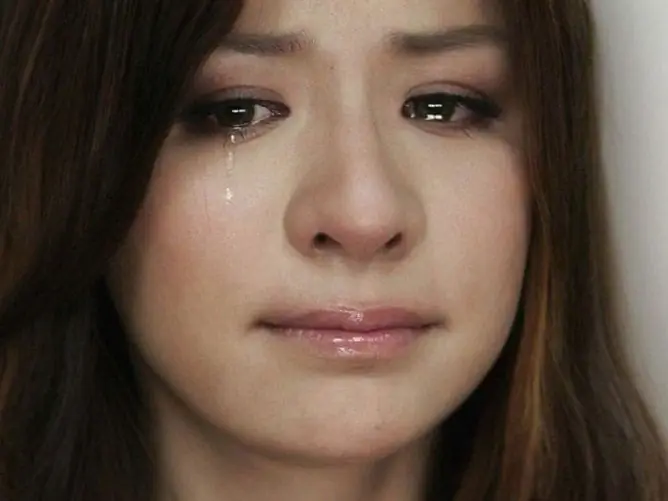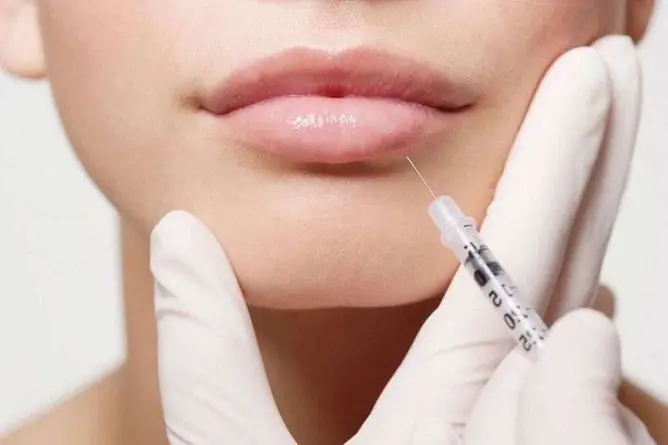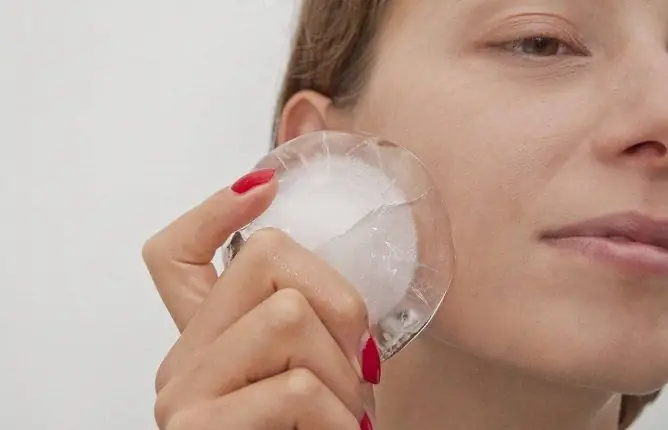- Author Rachel Wainwright [email protected].
- Public 2023-12-15 07:39.
- Last modified 2025-11-02 20:14.
How to remove swelling after an insect bite
The content of the article:
- General principles of treatment
-
Providing help depending on insect
- Mosquito
- Bug
- Midge
- Flea
- Wasps and bees
- Hornet
- What is the evidence of edema?
- Dangerous symptoms
-
Further treatment
Folk recipes
- Video
Before removing the swelling after an insect bite, you need to determine the cause and type of lesion. Swelling can be caused by mosquitoes, bedbugs, lice, midges, fleas, bees, hornets and some other insects. Depending on the type of insect, the symptoms of damage are somewhat different. First aid can be provided at home, but if dangerous symptoms are present, you should immediately consult a doctor.

With increased sensitivity of the body, the bite of any insect can cause not only significant swelling, but also other unpleasant symptoms
General principles of treatment
The basic rules for providing care are the same for bites of any etiology. How to quickly help a patient:
- If possible, it is necessary to stop the entry of toxic substances or allergens into the body. For example, remove a sting from the skin, leave the place where midges accumulate.
- Rinse the bite site with cold water, or soapy water.
- Treat the skin with an antiseptic solution to prevent the development of an infectious process.
- Apply a cold compress to the bite site. It is not recommended to apply ice directly to the skin; a bag or cloth should be placed.
These actions are aimed at reducing the negative consequences. At the same time, some actions can only increase the likelihood of an adverse outcome. What is contraindicated to do if the bitten area is swollen:
- apply heat to the affected area;
- apply warming ointments;
- squeeze the place of swelling;
- comb the skin.
These actions increase the blood supply to the area, so the poisonous or allergenic substance will be absorbed faster into the general bloodstream. If you scratch a wound, bacteria can enter through the scratching.
Providing help depending on insect
There are several methods on how to remove swelling after an insect bite at home. Treatment tactics depend on two main factors - the type of insect and the type of reaction (allergic, toxic). You can determine the type of insect by the clinical picture - the nature of the rash, their localization, the presence or absence of itching, signs of intoxication.
Mosquito
Mosquito saliva contains allergens that enter the body and cause a response. A mosquito bite can cause not only swelling, but other symptoms as well:
- itchy skin - occurs in almost all cases;
- redness at the site of the lesion;
- blistering rash.
The edema is usually local, takes from 5 mm to several cm. On palpation, a swelling of a dense consistency is determined, painless.
A cold compress can be made with ice and a cloth. A little ice is wrapped in a piece of cloth and applied to the skin for 10-15 minutes.
To relieve symptoms, the skin is treated with ammonia or soda solution. To prepare the solution, half a teaspoon of soda must be diluted in a glass of water.
Bug
Bedbugs bite a person at night, insects hide in furniture, crevices in walls. Pathological symptoms are caused by the secretion of the salivary glands of bedbugs. Bedbug bites on the skin are manifested by multiple rashes, swelling and redness.
The rash appears as papules or vesicles (as seen in the photo). They can be localized anywhere on the body, located in a line or in small groups. The skin at the site of the rash itches. Around the elements of the rash, dense edema appears, which occurs due to an allergic reaction to the saliva of bedbugs.
There is no specific treatment for bedbugs. In most cases, symptoms resolve on their own within 2 weeks. Prevention consists in the destruction of bedbugs.

Bedbug bites are usually multiple, they look like papules or vesicles
Midge
Midges are small blood-sucking insects. Their saliva contains poison, which, when it enters the human body, has a hemolytic effect.
Damage symptoms:
- sharp itching;
- burning;
- swelling of the skin;
- local redness.
A midge bite causes a toxic, not an allergic reaction in the body. Therefore, general symptoms of intoxication may develop - weakness, fever, chills, muscle pain.
First aid is based on general principles - to leave the place of accumulation of midges, apply cold to the affected area, rinse with cold water. With the development of symptoms of intoxication, you should immediately consult a doctor. Prescribed glucocorticoids, subcutaneous injections of adrenaline.
Flea
Flea bites are most often localized on the lower extremities - in the feet and legs. They appear as small red patches that rise above the skin. Symptoms appear immediately after the bite. In addition to the rash, other signs are observed:
- slight swelling;
- itching;
- burning.
Usually, swelling after a flea bite does not pose a danger to humans. An exception is when the rash is generalized. This is observed in individuals with allergies. Moreover, the child is more sensitive to flea bites than an adult. In children, allergy symptoms are more pronounced - with a predisposition to allergies, a generalized rash and swelling of the respiratory tract quickly develop.
Treatment consists in removing parasites, treating the wound with an antiseptic solution. For itching and swelling, the skin is treated with menthol or salicylic alcohol. No specific treatment is performed.
Wasps and bees
Hymenoptera, including wasps are poisonous, can bite and sting humans. The injection is made with a sting and is accompanied by the release of a toxic liquid, which is produced in special glands.
Their venom contains histamine (a substance that causes vasodilation and edema) and allergenic proteins that can cause anaphylactic reactions.
The clinical picture depends on several factors:
- the number of bites (single or multiple);
- localization - bites in the face, neck and tongue are especially dangerous, as this can lead to airway obstruction;
- sensitivity (normal, increased).
A single bite in the leg or arm, if the person does not have hypersensitivity, is not dangerous. In this case, you can limit yourself to general recommendations:
- Stop the supply of poison - carefully pull out the sting.
- Additionally, a tourniquet can be applied above the bite site.
- Apply a cold compress to the affected area.
If a bee or a wasp has bitten a person on the head, face, neck, tongue, emergency assistance is required. In addition to general recommendations (pull out the sting, apply cold), it is necessary to use medications: glucocorticoids or antihistamines. If the swelling spreads quickly, adrenaline may be needed.
Hornet
The hornet bite is also a danger to human life. The hornet can sting several times in a row, while in most cases the sting does not remain in the skin. The danger is that with each bite, the hornet injects poison, and the more bites, the greater the concentration of the poison.
Symptoms that arise in this case:
- pronounced edema, both local and generalized;
- pain in the affected area;
- burning sensation, tingling sensation.
Edema comes to the fore, in severe cases - signs of intoxication. Weakness, nausea, decreased blood pressure, increased heart rate, and respiratory failure may occur.
The first thing to do is to examine the site of the lesion. If a sting remains there, it must be removed. In no case should you squeeze out the sting; use tweezers to remove it. Then you should rinse the bite site, apply a cold compress.

A hornet bite can have dire consequences.
What is the evidence of edema?
Edema is a local reaction of the body to the ingress of foreign substances. Swelling can be a symptom of both allergic and toxic reactions.
In case of an allergic reaction, the cause is the ingress of the allergen. The most common allergen is insect saliva.
A toxic reaction is triggered by the ingress of a poisonous substance. The poison is injected by the hornet, wasp, bee, midge.
In most cases, edema occupies a small area and has clear boundaries.
Less often, edema from the bite site spreads further along the adipose tissue. This indicates a systemic reaction of the body.
Dangerous symptoms
Swelling of the skin can be the initial symptom of an anaphylactic reaction, a life-threatening condition that requires emergency care. What symptoms should you pay attention to:
- generalized rash;
- signs of intoxication - a violation of general well-being, weakness, fever;
- swelling of the respiratory tract - manifests itself in the form of choking;
- systemic signs - pallor of the skin, tachycardia, hypotension.
If these signs occur, you should immediately seek medical attention. Home treatment can have dangerous consequences.
Further treatment
With unexpressed changes, there are often enough general measures - skin treatment, termination of contact with the allergen. In more severe cases, medication is prescribed. If the cause of the edema is an allergic reaction, then antiallergic therapy is prescribed. It includes the use of the following tools:
| Group of drugs | Explanation | Name of drugs |
| Antihistamines |
In most cases, the cause of the swelling is an allergic reaction. Antihistamines can help reduce allergy symptoms, including swelling, itching, and redness. Some antihistamines affect the central nervous system, causing drowsiness and decreased concentration. Such drugs can be prescribed to children who have sleep disturbances due to itching. But they are contraindicated in adults who drive vehicles. |
Diphenhydramine (causes drowsiness) Donormil (causes drowsiness), Suprastin, Tavegil, Fenistil, Claritin. |
| Glucocorticoids in the form of ointments |
For local edema, glucocorticoids are used in the form of ointments. The ointment should be applied in a thin layer 2-3 times a day. This will reduce swelling, itching, redness, and pain. The duration of treatment is on average 3-5 days. It is contraindicated to use glucocorticoids if the bite site is infected (with the formation of crusts, the presence of pus). |
Hydrocortisone, Ultralan, Dermatop, Prednisolone, Deperzolone. |
| Glucocorticoids in the form of tablets or ampoules for injection | In severe cases, parenteral administration of glucocorticoids is prescribed. Systemic glucocorticoids are indicated for the development of an anaphylactic reaction. | Prednisolone, Dexamethasone |
If the cause is a toxic reaction, in addition to glucocorticoids, infusion therapy is prescribed. Intravenous drip of saline solutions is carried out, this allows to reduce intoxication.
Folk recipes
In addition, folk remedies can be used to treat edema. They can reduce the symptoms of allergies, but they will not completely eliminate the pathology.
Folk remedies for local use are mainly used:
- Aloe. Whole leaves can be applied to the edematous area (after removing the peel) or compresses with aloe juice.
- Baking soda. Dissolve a teaspoon of baking soda in a glass of water. The resulting solution is applied to the edematous area 4 times a day.
- Parsley. Parsley compress can help reduce swelling. For preparation, 1 tablespoon of parsley leaves must be chopped and placed on the skin over a gauze bandage.
- Essential oils. For example, mint, eucalyptus, rosemary. To reduce swelling and itching, 1-2 drops of essential oil are enough.
Folk remedies are not a panacea. If symptoms persist for 3 days or more, you should definitely see a doctor.
Video
We offer for viewing a video on the topic of the article.

Anna Kozlova Medical journalist About the author
Education: Rostov State Medical University, specialty "General Medicine".
Found a mistake in the text? Select it and press Ctrl + Enter.






